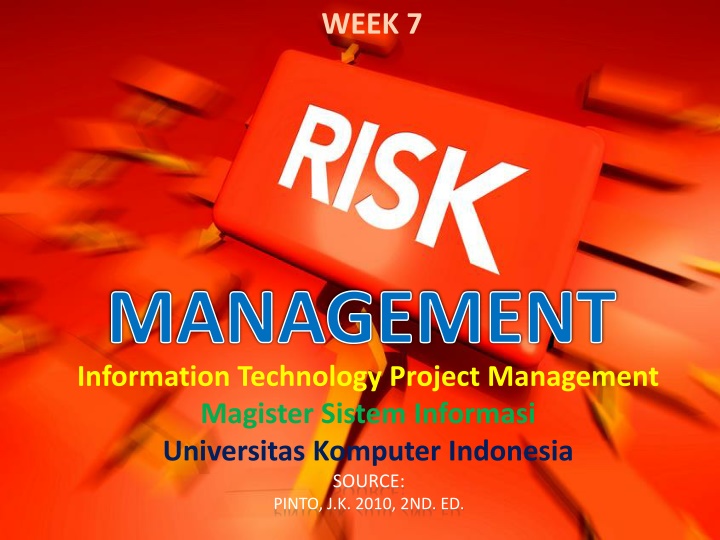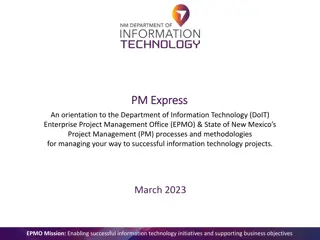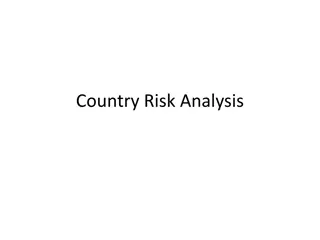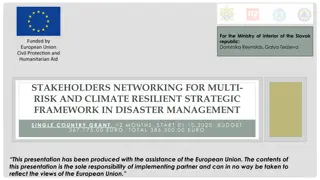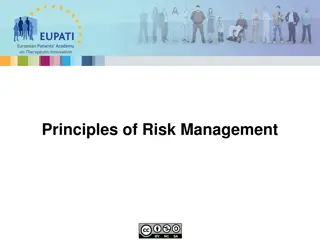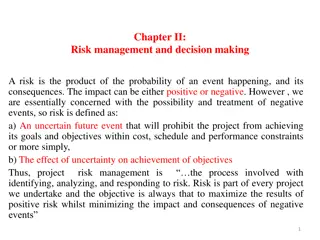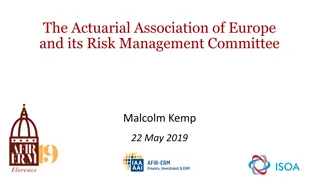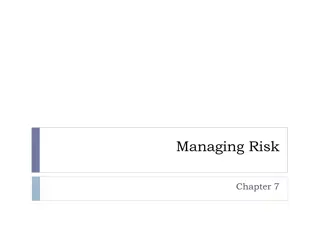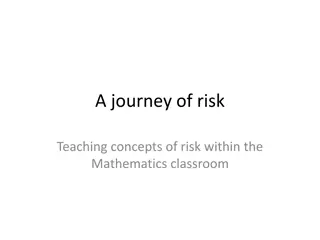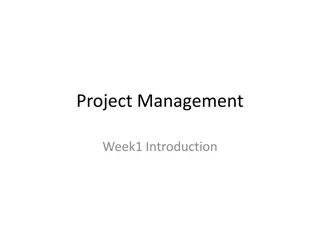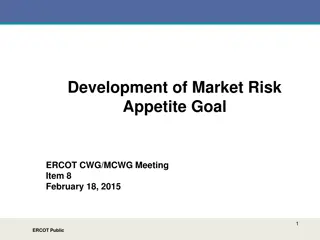Risk Management in Information Technology Project
Project risk is any potential event that can harm a project's success. Risk management involves identifying, analyzing, and responding to risks throughout the project's lifecycle to safeguard its objectives. The process includes risk identification, analysis of probability and consequences, risk mitigation strategies, and control/documentation. Risks can include financial, technical, commercial, execution, and contractual/legal. Methods like brainstorming, expert opinion, history, and team assessment help in identifying risks. Typical risk variables encompass promotion, market volume, market price, political, technical, financing, environmental, cost estimate, schedule, operating, organizational, integration, and acts of God.
Download Presentation

Please find below an Image/Link to download the presentation.
The content on the website is provided AS IS for your information and personal use only. It may not be sold, licensed, or shared on other websites without obtaining consent from the author.If you encounter any issues during the download, it is possible that the publisher has removed the file from their server.
You are allowed to download the files provided on this website for personal or commercial use, subject to the condition that they are used lawfully. All files are the property of their respective owners.
The content on the website is provided AS IS for your information and personal use only. It may not be sold, licensed, or shared on other websites without obtaining consent from the author.
E N D
Presentation Transcript
WEEK 7 MANAGEMENT Information Technology Project Management Magister Sistem Informasi Universitas Komputer Indonesia SOURCE: PINTO, J.K. 2010, 2ND. ED.
PROJECT Project Risk, is any possible event that can negatively affect the viability of a project.
RISK MANAGEMENT Risk Management is the art and science of identifying, analyzing, and responding to risk factors throughout the life of the project and in the best interests of its objectives.
PROCESS OF RISK MANAGEMENT Risk Identification the process of determining the specific risk factors that can reasonably be expected to affect our project. Analysis of Probability and Consequences the potential impact of these risk factors, determined by how likely they are to occur and the effect they would have on the project if they did occur. Risk Mitigation Strategies steps taken to minimize the potential impact of those risk factors deemed sufficiently threatening to the project. Control and Documentation creating a knowledge base for future projects based on lessons learned.
RISK IDENTIFICATION Financial Risk Technical Risk Commercial Risk Execution Risk Contractual or Legal Risk Others: Absenteeism, Resignation, Staff pulled away by management, Additional staff/skills not available, Training not as effective as desired, Initial specifications poorly or incompletely specified, Work or change orders multiply due to various problems, etc.
RISK IDENTIFICATION METHOD Brainstorming meetings Bringing the members of the projects team, top management and even clients together for a brainstorming meeting can generate a good list of potential risk factors. Expert Opinion The collective wisdom of sets of experts is then used as the basis for decision making. History In many cases the best source of information on future risk is history. Multiple (or team based) Assesment A team based approach to risk factor identification encourages identification of more comprehensive set of potential project risks.
TYPICAL RISK VARIABLES (Jafary, 2001:85, Management of Risks, International Journal of Project Management, 19(2)) Promotion Risk Market Risk, volume Market Risk, price Political Risks Technical Risks Financing Risks Environmental Risks Cost Estimate Risk (completion risk) Schedule Risk (delay risk) Operating Risk Organizational Risk Integration Risk Acts of God
ANALYSIS OF PROBABILITY & CONSEQUENCES Risk = (Probability of Event)(Consequences of Event). Risk Impact Matrix: Consequences Low High High Likelihood Low
ANALYSIS OF PROBABILITY & CONSEQUENCES Example: DEVELOPING A NEW SOFTWARE PRODUCT FOR THE RETAIL MARKET Risk Factor Consequences Likelihood Impact Potential A. Loss of lead programmer High Low Moderate B. Technical failure High Medium Serious C. Budget cut Medium Low Minor D. Competitor first to market High High Serious Consequences Low Medium High high Likelihood Low Medium
DETERMINING LIKELY RISKS & CONSEQUENCES Probability of Failure (Pf) SCORE MATURITY COMPLEXITY DEPENDENCY Low (0.1) Existing software Simple design Not limited to existing system Minor (0.3) Minor redesign Minor increase in complexity Schedule or performance depend on existing system Moderate (0.5) Major change Moderate increase Moderate risk to schedule or performance Significant (0.7) Tech. available but complex design Significant increase Schedule or performance depend on new system or process. Significant cost or risk Major (0.9) State of art, some research complete Extremely complex Schedule or performance depend on new system or process. Very high risk. Consequences of Failure (Cf) SCORE COST SCHEDULE RELIABILITY PERFORMANCE Low (0.1) Budget estimate not exceeded Negligible/ no impact Minimal or no reliability consequences Minimal or no performance consequences Minor (0.3) Cost estimate exceeds budget < 5% Minor slip in schedule Small reduction in reliability Small reduction in system performance Moderate (0.5) Cost estimate exceeds budget < 15% Small slip in schedule Some reduction in reliability Some reduction in system performance Significant (0.7) Cost estimate exceeds budget < 30% Slips excess 1 month Significant degradation in reliability Significant degradation in system performance Major (0.9) Cost estimate exceeds budget < 50% Large schedule slip Reliability goals cannot be achieved under current plan Performance goals cannot be achieved
CALCULATING A PROJECT RISK FACTOR Use the project team consensus to determine the scores for each Probability of Failure Category: Maturity (Pm), Complexity (Pc), Dependency (Pd). Calculate Pf by adding the three categories and dividing by 3: Pf=(Pm+Pc+Pd)/3. Determine the scores for each Consequences of Failure Category: Cost (Cc), Schedule (Cs), Reliability (Cr), Performance (Cp). Calculate Cf by adding the three categories and dividing by 4: Cf=(Cc+Cs+Cr+Cp)/4. Calculate Overall Risk Factor for the project by using the formula: RF=Pf+Cf-(Pf)(Cf) Rule of Thumb: Low risk Medium risk High risk Rf < 0.3 Rf = 0.3 to 0.7 Rf > 0.7
QUANTITATIVE RISK ASESSMENT Assume your project team has decided upon the following risk values: Pm = .1, Pc = .5, Pd = .9 Cc = .7, Cs = .5, Cr = .3, Cp = .1 Determine the overall Project Risk using qualitative method
RISK MITIGATION STRATEGIES Accept Risk Minimize Risk Share Risk Transfer Risk Use of Contingency Reserves
CONTROL AND DOCUMENTATION Control and documentation methods help manager classify and codify the various risks the firm faces, its responses to these risks, and the outcome of its response strategies. Control document has to coherently identify the key information: what, who, when, why, how.
PROJECT RISK ANALISYS & MANAGEMENT (The European Association for Project Management) Define Focus Identify Structure Clarify Ownership of Risk Estimate Evaluate Plan Manage
